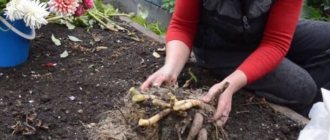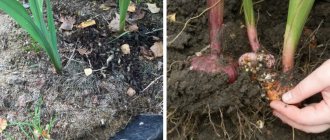- TULIPS: Which tulips should be dug up every year?
- When to dig up tulips?
- Should I pick a flower?
- How to properly dig and store bulbs after digging?
- What to do with small onions?
- Do I need to dig up daffodils every year?
- When to dig up hyacinths
- When to dig up lilies Lilies from the Asian hybrids and LA hybrids groups
- When to dig up crocuses
When to dig up tulips
It is advisable to dig up tulip bulbs in the northern zone from mid-July to the first days of August, in the southern regions (for example, in the Kursk, Lipetsk, Voronezh regions) - in late June - early July. In the middle zone (for example, in the Moscow region, Smolensk, Tver, Leningrad regions), the time for digging up tulips usually occurs at the end of June - beginning of July.
Is it possible to plant tulips in the spring, during flowering? In May and early June during flowering, it is not recommended to replant tulips with flowers. Digging up tulips immediately after flowering will crush the bulbs and lead to fewer flowering plants the following year. Therefore, the harvesting of tulip bulbs begins only after the leaves and stems have completely dried, and the early varieties should be dug up first, and the middle and late varieties should be dug up as the leaves fade.
There is no need to dig up tulips for the winter; they overwinter well in open ground conditions.
In the photo: freshly dug tulip bulbs.
Reasons for replanting tulips
It is recommended to replant flowers annually for several reasons, namely:
- preservation of plant varietal characteristics;
- slowing down the rapid development of the tulip;
- the planting remains decorative.
Did you know? Flower bulbs were sold very expensively in the Netherlands in
the mid-17th century . Each of them was more expensive than the house of a person with an average income. In their natural habitat, tulip bulbs grow on the mountains, and every year sewage water deepens them into the ground, which leads to the death of the plant. In garden plots, approximately the same process occurs, which is why annual replanting of tulips is so important. Then the flowering of this spring plant will delight you every year.
Is it necessary to pick a flower from a tulip?
To get good, strong tulip bulbs, do not let the plant waste energy setting seeds. Remove the flower head from tulips 3-4 days after the flower opens. When plants in a flower garden fade, it is necessary to remove only the seed capsule, leaving the maximum possible length of the peduncle and leaves. This will cause nutrients to flow from the aboveground part of the plant into the bulb and help it gain strength for flowering next year.
Tie the flower stalks of tulips with large double flowers to the support (for example, representatives of the Late Terry class)
Leave at least 3-4 leaves when cutting tulips for a bouquet. This will help the plants form large bulbs capable of flowering next spring.
Timing for harvesting tubers: favorable days and unfavorable days (table)
You need to dig up plant tubers during the waning phase of the moon. At this time, nutrients are directed downward from the leaves and trunks and concentrated in the root area. Bulbs in the ground grow better and faster.
When choosing a specific date for digging up plant bulbs, you need to take into account the instructions of the lunar calendar. Of great importance is the zodiac sign in which the celestial body is located. The most successful are Aries, Leo, Cancer.
How to properly dig and store tulip bulbs after digging
Try to dig up tulip bulbs after flowering in dry and clear weather. To avoid accidentally damaging the bulbs, be guided by the remains of dried stems. Handle small tulip bulbs very carefully - this is planting material with which you can propagate tulips. Take special care to dig up small bulbs in which the replacement bulb becomes deeper.
Tulip bulbs must be sorted by variety, placed in boxes labeled with the names of the varieties and removed from direct sunlight in a utility room or under a canopy. After a few days, the tulip bulbs are cleaned of roots, soil residues and old scales, and taken apart. Healthy tulip bulbs should have light brown scales. Sorted and dried bulbs are laid out in a thin layer in boxes and stored in a warm room for about 20 days at a temperature of +23°C and a humidity of 70-80%. At this time, flower shoots, leaves and root buds are formed. If the temperature at this time is too low, about +5 degrees Celsius, then bud formation does not occur and the bulb does not bloom the next year. Gradually, you need to find a cooler room for storing the bulbs and, until planting, store them at +13...+15° and a humidity not higher than 70%.
How to sort tulip bulbs >>>
In the photo: newly dug bulbs and baby tulips with roots.
Storing tulip bulbs before autumn planting
When storing tulip bulbs, the correct temperature is of great importance. This is important so that the flower arrow can be formed.
For the first month, the bulbs should be kept warm, at a temperature not lower than 23 ° C and normal air humidity (40-60%). It is important that the air in the room is constantly exchanged; if it stagnates, mold can develop on the bulbs.
In dry, sunny weather, you can continue to keep the bulbs under a canopy outside, in the same place where they dried. If the weather turns bad and it starts to rain, the planting material is brought into the house, where it can be stored under the bed or in a dry pantry.
Some varieties of tulips (parrot, fringed) require a higher temperature for storage in the first month - about 30 ° C. It is under these conditions that the flower arrow matures.
Starting from August, the storage temperature is slightly reduced, it is advisable that at this stage it does not exceed 20 °C. Closer to September, the temperature needs to be lowered a little more - to 15-16 °C.
However, the humidity should still remain low, so outdoor storage conditions will no longer be suitable at this stage; a barn or enclosed veranda can be used for this purpose. This temperature schedule may seem complicated to some, but it is necessary to adhere to it. These are the needs of the plant.
First, in the warmth of the tulips, flower arrows are laid, then replacement buds are formed, leaves are laid, after 2 months the future parts of the flower (pistil, stamens, ovaries) are formed. If the required temperature schedule is not observed, the tulips may not bloom in the future or blind (unopened) buds may be expelled.
What to do with small tulip bulbs
Tulip bulbs should be stored in a warm room until autumn planting, and small bulbs - baby tulips - on the contrary, should be stored in a cool place, otherwise they dry out very quickly and may dry out completely. It is important to ensure protection from mice and periodically check the bulbs. At the beginning of August, baby tulips can be planted for growing - in a school or in a garden bed. If you do not have the opportunity to store small bulbs separately, you can plant them immediately - then do not forget to water and weed the plants.
How to plant
Treat your tulip bulbs before planting in the fall to protect them from fungal infections. For this purpose, special preparations are produced that can be replaced with ordinary potassium permanganate. Inspect again: healthy and diseased plants cannot be planted together. Affected bulbs must be disposed of.
Planting depth of tulip bulbs
The standard scheme for planting tulips is as follows: rows are made at a distance of 25-30 cm. Their location should fit organically into the perimeter of the flowerbed. The distance between the bulbs is 8-10 cm. Planting depth depends on the size:
- Children: 5-10 cm.
- III and II analysis: 12 cm.
- I analysis: 15 cm.
Keep in mind that small bulbs produce small flowers. To avoid being shaded by taller flowers, plant them at the edge of the flowerbed on the south side. If you like the “uncultivated” look, then there is no need for combination. Create wider spacing between flowers and enjoy the natural state of your garden.
If you are interested in landscape design, then plant tulips according to the pattern. When compiling it, take into account the timing of flowering, the diameter of the inflorescence, and the color of the petals. Think over and sketch in advance the scheme according to which you will plant the bulbs. The picture can be supplemented with other primroses.
Video “Planting tulips in autumn: diagram, depth, planting dates”
Do I need to dig up daffodils every year?
Many people ask why daffodils don’t bloom in the garden and whether they need to be dug up after flowering. Daffodils do not like frequent division and replanting. For lush flowering, they must remain in one place for about 5 years. You can dig up and divide the bulbs 3 years after planting, if additional planting material is really needed. Still, it is better not to disturb daffodils too often: some varieties may weaken and miss flowering the next year or even not bloom after the last transplant for 2 years in a row until they are “sure” that they have been left alone.
Read more: How and when to dig up daffodils >>>.
In the photo: a newly dug curtain of daffodils.
How to prepare bulbs for storage step by step
Now let's look at the algorithm for preparing tulip bulbs for storage.
Step 1. You have removed all the bulbs from the soil. Inspect them and set aside any that are rotten, diseased or damaged.
Step 2 : Calibrate. By sorting the bulbs by size, in the future you will be able to organize a flower bed and plant them beautifully.
Step 3 : Clean. It is necessary to remove adhering soil, roots, peeling husks, etc.
You may also need to cut off any rotten areas on the bulb. Please note that if there is little rot, then it is easier to remove it, but if there is a lot, then the onion will have to be thrown away.
And don’t forget to treat the cut area with potassium permanganate and crushed activated carbon.
An important point about the husk. There is no need to specially “undress” the bulbs. Clean off only those scales that easily come off on their own. Otherwise, you may damage the rhizome.
Step 4. Drying the planting material. The bulbs must be dried before storing.
This can be done by placing the rhizomes in mesh boxes in 1 - 2 layers. There is no need to apply more, as then the process of rotting may begin.
Drying time can vary from several days to 2 weeks. Everything, as you understand, depends on the weather.
Step 5. Disinfection. The simplest way to disinfect planting material is to soak it for several hours in a pale solution of potassium permanganate. Don’t forget that you need to dry the bulbs again later.
Step 6. Bookmark for storage. Choose the method that suits you to store planting material and do not forget to provide the necessary storage conditions.
ON A NOTE. If the bulbs have grown together into nests, then they need to be carefully separated, peeled, cut off the roots and soaked for 30 minutes in a weak solution of potassium permanganate. Then they are dried again and sent for storage.
When to dig up daffodils after flowering
You need to dig up daffodil bulbs and plant nests on average once every 4-5 (up to 6) years, when the bulbs begin to crowd each other and flowering weakens.
The timing for digging and planting daffodils differs from tulips and hyacinths. Although the narcissus foliage dies back after flowering, it does not have a pronounced dormant period. Nutrients move in the bulb, and organs form and develop. Daffodils should be dug later than tulips and hyacinths, as soon as the foliage turns almost completely yellow (June-July), and planted earlier - before the end of September. The optimal time to dig up daffodils is the second half of August, since the roots of daffodils grow most actively in September.
Do not rush to dig up daffodils until their foliage completely turns yellow. The bulb must have time to draw all the nutrients from the leaves and put them aside in reserve. For daffodils, this period can last almost 2 months, and in damp weather it can be even longer.
After waiting for the foliage to turn yellow, it is better not to delay digging up the daffodils: when the leaves dry out and fall off, the exact location of the bulbs will be difficult to determine, and you risk accidentally damaging them.
How to properly disassemble, divide and prepare daffodil bulbs for storage >>>.
In the photo: dividing daffodils after digging.
Care after transplant
The future development of the tulip depends on what care is provided to the plant after transplantation.
We recommend reading about the violet variety Magic Tulip.
The details of this procedure can be divided into several important stages:
- The soil surface is compacted and compacted. Mulch the soil. For this, sawdust or fallen pine needles are used. Such care guarantees the safety of the bulbs during the winter.
- It is necessary to plant according to varieties.
- If there is no rain during this period, the soil should be constantly moistened. As soon as frost appears, this process should be stopped.
- After the first shoots appear above the surface of the earth, they should be carefully examined. Remove those that are damaged or infected. All rejected material is destroyed, as it can harm the entire plantation.
- The soil is constantly loosened. This will allow the root system to receive a constant supply of oxygen. This effect has a beneficial effect on the growth and development of the plant. This procedure is repeated after each watering or precipitation.
- Constantly add a small amount of water. Frequent watering makes the flower bed waterlogged. Excessive moisture leads to rot. Slightly increasing the watering rate is allowed only during the flowering period.
- After the first shoots appear, fertilizing should be done. The presence of nitrogen in fertilizers is mandatory, since it is this element that improves the growth and formation of leaves.
- During subsequent plant growth, fertilizing is not needed. It is only possible to apply complex fertilizer with useful microelements.
- At the moment of formation of the first buds, a second feeding with nitrogen-containing and phosphorus-containing substances is often carried out. During this period, tulips require more nutritional components.
- The last feeding of the plant is carried out when the last blossom falls. At the same time, fertilizers should contain potassium and phosphorus, but not nitrogen.
When to dig up hyacinths
Hyacinths must be planted and dug up every year, otherwise it will not be possible to preserve the varietal characteristics of the plants. In the conditions of the middle zone, for the normal formation of vegetative organs and inflorescences of the next year, it is advisable to dig up hyacinth bulbs annually. Without this, flowering weakens already in the second year, and then completely disappears.
It is best to dig up hyacinths in late June-early July, when the leaves turn yellow. The dug up bulbs are carefully cleaned of soil, the leaves are cut off and dried for 2-3 days. Then they clean off excess scales, roots, growths on the bottom, separate large new bulbs (babies) and put them away for storage. The total storage duration is about 95 days. Of these, it is advisable to store the bulbs for 2 months at a temperature of +25...+26°C, then for a month at +17°C. The humidity in the room where the bulbs are stored should not be too low so that they do not dry out. To maintain moisture, you can spray the bulbs with water from time to time.
In the photo: bulbs of dug up hyacinths.
How to grow large hyacinths >>>
Favorable days according to the 2020 Lunar calendar for gardening and gardening for digging hyacinths: 6, 11-13, 16-18 (the most favorable days), June 28-29, July 10-15.
Storage methods
Prepared and sorted rhizomes should be stored in containers where free air circulation is possible. These requirements are met by wooden boxes, plastic containers, egg boxes, and thick cardboard boxes with holes made in advance.
Attention!
If the storage container is closed, then the ethylene released by the tulips begins to accumulate in it. And it has a detrimental effect on the viability of flowers.
The bulbs must be laid out in one layer so that they do not touch each other. To avoid the development of infectious diseases, boxes must be ventilated weekly. If the first signs of the disease appear, then the affected area, provided that it is not large, must be cut off with a sharp knife and then sprinkled with ash or treated with hydrogen peroxide. If the affected area is large, then you need to get rid of the bulb.
If you cannot plant flower rhizomes before autumn, there are various ways to store them. The main condition for winter storage is stratification. If you neglect it, then after planting the flowers will not appear.
The most popular methods for preserving bulbs:
- Wet germination. He suggests that wet sawdust or high peat should be placed in plastic containers. Place planting material on top of it and sprinkle with a little substrate. Store in the cellar. If tulip bulbs sprouted in this way, they will bloom at the usual time.
- Dry storage. If there are only a few rhizomes, they can be stored in the refrigerator in the compartment for fresh vegetables until planting. Each unit must be wrapped in paper. Optimal storage conditions are also found in the basement. But for this it is important to sprinkle the bulbs with sand or dry sawdust. Crops planted in spring begin to bloom later.
- Early forcing. This method is suitable if there is a risk that the tulip will not be preserved in the usual way. According to it, the bulbs need to be planted in a container with garden soil. Until the first frost, you can store them on the balcony or veranda, and then cover them with film and lower them into the basement. Ventilation is necessary every 14 days, watering is needed as the soil dries out. As soon as the first shoots hatch, the container must be exposed to light.
But even if you ensure proper cultivation and proper care, there is still a high risk that the planting material will not “survive” until the next planting. Therefore, it is necessary to observe the deadlines and not store the bulbs for winter storage.
Storage locations
Rhizomes that have already been sorted and cleaned should be placed in a dry, warm and well-ventilated room. This could be an attic, a barn, a cottage. Before planting in the fall, they will be stored there at a temperature of 25 to 28℃.
In city conditions, storage of bulbs can be organized on the balcony. But at the same time it is necessary to exclude direct sunlight from hitting them. It is acceptable to keep boxes on the windowsill. In country houses, tulips are often stored in the attic. At the same time, they must be placed so that access to rodents is limited.
Conditions for tulips
In the case when tulips are intended for autumn planting, the storage temperature should be 23-25℃ plus at the beginning of planting, and before planting the bulbs this figure should be reduced to 15℃ above zero.
The humidity level should be optimal - 60-70%. If this indicator is lower, the fleshy membranes of the rhizome will shrink, so there must be ventilation and protection from direct sunlight.
Attention!
If this happens, the air in the storage should be slightly humidified.
If there is an excess of it, earlier germination will occur, as well as the proliferation of putrefactive microorganisms. The room used for storage must be well ventilated.
When to dig up lilies
Lilies require replanting every 3–4 years. Due to the perennial subbulb roots, lilies have virtually no storage period: the loss of these roots can result in the plant not blooming after planting. Therefore, summer-autumn digging and dividing of lilies should coincide with transplanting and planting in a new place. If necessary, lilies can be transplanted at any time of the season without disturbing the ball of earth with roots.
Lilies from the groups Asian hybrids and LA hybrids
Lilies from the groups Asian hybrids and LA hybrids usually form a lot of children, so try to dig them up and plant them every year, otherwise they will greatly weaken the mother bulb, flowering will be weak and short-lived.
Lilies from the groups Oriental hybrids, Martagon, tubular and OT hybrids
Lilies from the groups Eastern hybrids, Martagon, tubular and OT hybrids usually produce few children per season. Therefore, lilies of these groups do not need to be planted every year; it is enough to plant them once every 5-7 years.
In the photo: lily bulbs prepared for sale after digging.
The time for transplanting lilies to a new place should coincide with the end of the growing season, when the lily bulbs get stronger after flowering. In the northern regions, the best time for transplantation is early autumn (late August - September), in the middle zone - mid-autumn (September - early October), in the southern regions - late autumn (October - November).
Timing for digging up lilies
In order for the plants to take root well in a new place and prepare for winter, it is better to divide the lilies at the following times:
— Asian and LA hybrids – from August 15 to 20;
— OT hybrids – from August 25 to September 1;
— Oriental hybrids – from September 1 to 5.
It is better to dig up non-winter-hardy tubular lilies every year for the winter, dry them and store them in a frost-free room.
Immediately plant all dug up lily bulbs in a permanent place.
If necessary, lily bulbs can be stored for a short time wrapped in sphagnum moss in a cool place, for example, in the vegetable compartment of the refrigerator. When digging up overgrown lilies, carefully separate all the resulting baby bulbs and plant them in specially prepared places.
How to plant lilies correctly >>>.
Planting and caring for tulips in the Urals
The Ural climate is continental, characterized by fairly cold winters and moderately warm summers. Therefore, growing tulips has its own characteristics, expressed mainly in the timing of care activities.
When to cut faded tulips
Fading flowers are cut a few days after the bud has fully opened, so the bulb can replenish its supply of nutrients faster and more efficiently. You can only remove the flower itself, leaving the peduncle in place.
For the Urals, this moment comes in June. As with normal tulip care, the plant continues to be watered until the leaves turn yellow and it is time to dig up the bulbs.
Important! When cutting tulips for the purpose of making bouquets, it is necessary to leave 1-2 leaves in place in order to allow the bulb to form better.
How to plant tulips and when
When to replant tulips depends on when they bloom. In the Urals, usually in July the bulbs are ready and you can dig them up. If the flowers grow too often, then when planting them again, they need to be planted further away from each other.
At the end of September in the Urals, the ground cools enough that tulips are planted in the ground. Planting stages:
- Treat the bulbs with a 5% solution of potassium permanganate;
- Sick, damaged bulbs are discarded;
- Children (small onions) are planted first, as they require more time to take root. It is necessary to take into account that larger tulips will grow from large bulbs, so they are planted in the central part of the bed, small ones - along the edges. This way, powerful plants will not prevent weaker ones from receiving enough sunlight;
- The bulbs are placed in holes, with the sharp tip up, to a depth of 10-15 cm. The composition of the soil also affects the planting depth. In heavy clay soils, tulips should be planted at a depth of less than 10 cm;
Important! Small onions should be placed closer to the surface of the earth.
- The bulbs should be planted so that the distance between them is at least 10 cm, so that the plant and flower can develop properly;
- A good way to protect bulbs from rodents is to plant them in baskets.
- Fill the holes with soil and cover the bed with spruce branches, dry grass or leaves to protect from frost. As soon as the snow melts, the covering can be removed.
Tulip bulbs are sensitive to excessive humidity and are prone to rotting. Therefore, it is recommended to plant them in places where moisture does not collect. It is better if it is a small hill.
Planting tulips in baskets
In the Urals, planting tulips in the spring is a big risk; the ground warms up too late for successful germination. To reduce this time, gardeners plant the bulbs in special containers, only then in open ground. This method may help.
How to preserve tulips before planting
After digging, the main task is to preserve the bulbs. If they were dug out of damp soil, then they must first be washed in lukewarm water, then dried, for example, in nets hung in a dry place.
Important! Only healthy onions can be stored. Rotten, wrinkled, dry, spotted ones should be thrown into the trash. They should not be placed in compost, because from there plant diseases can spread throughout the garden.
Once dried, store the bulbs in a dark, cool, dry place, such as a paper bag or basket. A cardboard box in which they are stacked in layers, each separated by newsprint, is also suitable. Experienced gardeners always label such boxes so as not to later confuse them with planting material for other plants.
Is it necessary to dig up and when is the imperial hazel grouse
Imperial hazel grouse bulbs can be grown in one place without replanting for 2–3 years. In nature, it grows in climates with hot and dry summers, and the bulbs need to warm up, just like in their homeland, in order to set a flower bud for next year. Therefore, to guarantee flowering, the imperial hazel grouse must be dug up every year and put away to dry at a temperature of +30°C until August. It is best to dig up bulbs when the above-ground parts begin to dry out - in mid-to-late June. You cannot delay cleaning; in humid summers there is a risk of bulbs rotting. Hazel grouse bulbs are devoid of covering scales, so during storage it is better to cover them with peat, sawdust or sand, otherwise they will dry out.
By the time storage ends at the end of August, hazel grouse bulbs begin to appear new roots and sprouts, long roots grow - this is a signal that it’s time to plant the bulbs.
In the photo: imperial hazel grouse bulbs prepared for autumn planting.
Bukhara hazel grouse (F. Bucharica) and stenantera (F. Stenanthera) also necessarily require digging and drying the bulbs every summer. This can be done by growing them in pots, removing the pot from the soil and putting it in a dry place until September.
The most popular and frost-resistant species of hazel grouse >>>.
How to propagate and keep different hazel grouse >>>.
Planting tulips in open ground in autumn
Storage of the bulbs continues until approximately mid-September. As soon as the soil temperature drops to +10-12 °C, you can begin planting tulips.
The specific timing of planting in the ground depends on the growing region and the weather. However, this work cannot be delayed too much; it is necessary to have time to carry it out 2 weeks before the onset of frost. The bulbs must have time to take root.
But planting tulips too early can also lead to trouble. In warm soil, the bulbs will begin to sprout, and then frost will destroy the emerging shoots, which can cause the bulbs to rot and disappear. Even if such a bulb survives, it may not flower or produce a bud too late and of poor quality.
- In the Moscow region, it is recommended to plant tulips from the twentieth of September to mid-October.
- In Siberia, bulbs are planted at the end of August.
- In the Urals, the landing can continue until the second ten days of October (Southern Urals) or end in mid-September (Northern Urals).
For planting, choose a sunny, flat or elevated place where water will not stagnate in the spring. In the shade, the quality of tulip flowering noticeably deteriorates. The bulbs are first placed in the refrigerator for 8 hours, and then treated with antifungal drugs and planted.
Tulips love loose, fertile soil. If the site has clay soil, its structure can be improved by adding sand and peat. The planting depth should be 3 times the size of the bulbs; the children are planted in a separate flowerbed.
Read more in the article: planting tulips in spring
When to dig up crocuses
Spring crocus can be grown in one place without replanting for 3–4 years. There is no need to dig up crocus corms every year unless you need to propagate the plant and get large marketable bulbs. The rate of growth of crocuses and the formation of daughter bulbs varies, and varietal plants need to be divided more often. When the corms crowd each other and become smaller, the nests need to be planted.
The timing of digging up crocuses depends on the flowering time of the plants. Autumn-flowering species (K. Banat, K. Pallas, K. beautiful, K. Kholmovoy, K. pretty, K. Sharoyan, K. Kochi, K. yellow-white, etc.) can be divided earlier - in June-August. Spring-flowering (K. spring, K. yellow, K. reticulated, K. Korolkova, K. two-flowered, K. Heichel, K. Sieber, K. golden, K. Ankyra, K. Adam, K. Alataevsky, K. Tomasini) - in July-September, when the plants are at rest. The planting material is dried, freed from roots and defective scales, after which it is inspected, diseased specimens are rejected, mechanical damage is disinfected by sprinkling with crushed coal or ash. Store in cool, dry rooms for two to three months, then plant in the ground.
In the photo: crocus bulbs prepared for autumn planting.
Disembarkation
Tulips are planted in the ground 6-8 weeks before the onset of frost, when the soil temperature drops to approximately +7...+10 ℃. Some gardeners advise doing this after the first frost. Before planting the bulbs, it is recommended to soak them in potassium permanganate for up to 30 minutes.
Autumn planting is sometimes carried out after the first frost.
Bulbs are planted at a depth three times their size : for large ones it is 12-14 cm, for small ones it is 6-8 cm.
Tulips can be planted in the same place every four years.
Before the onset of winter frosts, the soil can be mulched with a layer of peat (up to 3 cm thick). In spring, the mulch is removed immediately after the snow melts to avoid the bulbs getting warm.
When to dig up small bulbous plants
Small-bulbous plants (white flower, candyk, scylla, muscari, snowdrop, scilla, pushkinia and chionodox) do not need to be dug up every year. They can grow in one place for 4-5 years. It is necessary to divide and plant muscari for replanting when the nests have grown greatly, so that they do not interfere with each other and the flowers are large. You can start working when the leaves of the plants begin to dry - in late summer-early autumn. If your muscari and other small bulbous plants are too young to divide and replant, simply trim off any yellowing leaves.
The dug up bulbs need to be cleaned of soil and roots, dried for several days in a well-ventilated area at an air humidity of 70% and a temperature of +17ºС. After this, the bulbs must be immediately transplanted to a new location. If planting is delayed, place the bulbs in a container of peat or damp sand to protect them from drying out.
In the photo: the process of digging muscuri during the flowering period.
Planting bulbs
When planting bulbs, you should correctly calculate the space in order to place all the planting material evenly, rooting it in the ground at a sufficient depth. When planting bulbs, consider the following points:
- Maintaining distance between planted bulbs. The larger the bulbs, the more space they require when planting. Children are allowed to be seated at a close distance next to each other. If you plant bulbs in rows, then the row spacing should be at least thirty centimeters;
When planting tulips, it is important to maintain the distance between the bulbs
When planting tulips in furrows, make sure that the planting material is the same size
Important! Before planting bulbs, make sure that no bulbous crops have grown in the same area of soil before, since fungal infections left behind by predecessors can be transmitted to the planting material.











